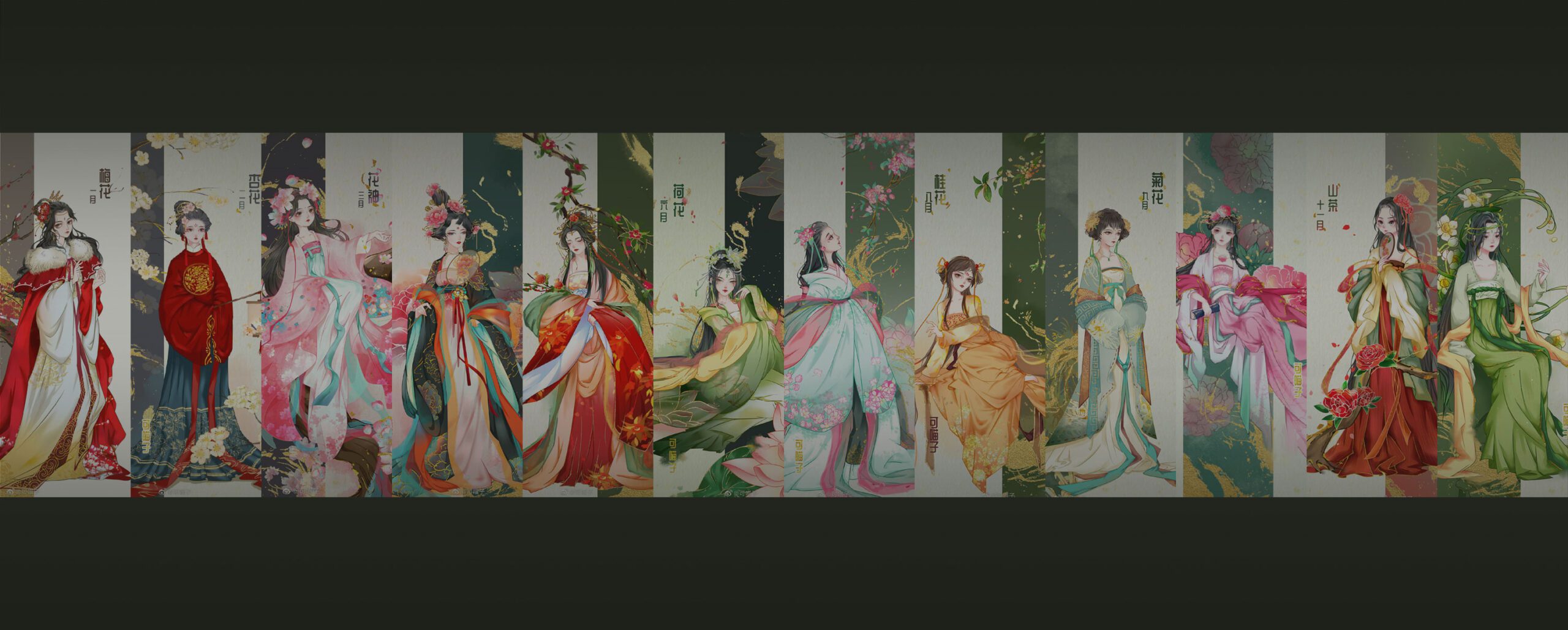Flowers by the Months
The Traditional Chinese Calendar is a Lunisolar Calendar, which includes 24 Solar Terms that correspond to the movement of the Sun, and 12 months to note the activities of the Moon.
Each month is represented by a flower with esoteric and cultural meanings. This forms the 12 flower months.
The flowers have been described and praised in poems, paintings, and artifacts in Chinese history. Each flower has a Chinese Flower Goddess to represent its beauty and qualities.
Enjoy the beautiful artwork by CatMeow.

Download this FREE 2023 with Flower Goddesses and print it from home.
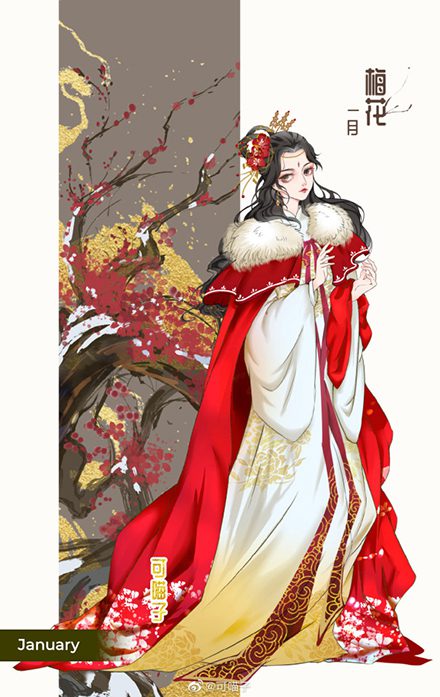
January Flower Plum Blossom
Flower of Strength, Nobility, and Modesty
Plum Blossom, the Flower of January, is also the flower of Five Blessings (in Chinese is Wufu), whose five petals represent happiness, wealth, longevity, peace, and success.
They blossom in the depths of harsh winter, therefore, the plum blossom has been representative of strength and courage.
First recorded more than 3,200 years ago, the plum was used for flavoring food and as sacrificial offerings.
Centuries later, more types of the flower were cultivated when Chinese people began to use plum blossoms in cosmetics, herbal medicine, and as ornamental flowers.
During Tang (618 — 907) and Song (960 — 1279) dynasties, more scholars and artists became fans of the beautiful flower blossoming in cold January, for its beautiful appearance, fragrance, and virtues, and developed a whole ornamental theory that includes appreciating place, time, shape, and activities, etc.
Plum blossom, together with orchid, bamboo, and chrysanthemum (September Flower), formed the “Four Gentlemen” or “Four Noble Ones” in Chinese art, each one represents some virtues and highly valued characters.
Since then, the plum blossom has been frequently praised in poems and artworks and is a popular decorative pattern in Chinese people’s daily lives.
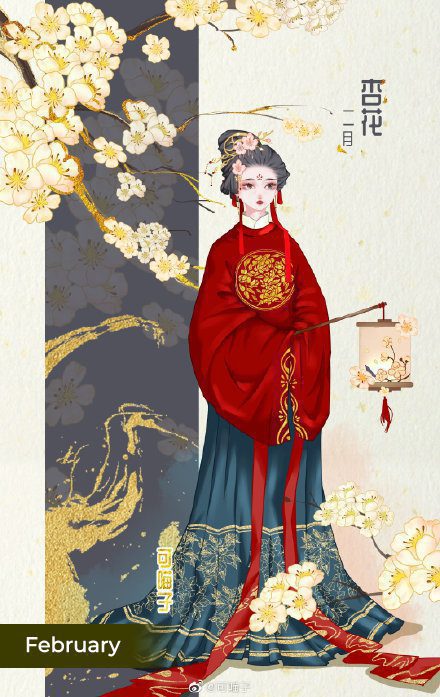
February Flower Apricot Blossom
Flower of Luck and Fortune
Apricot blossom, the Flower of February, has the same pronunciation as “lucky” in Chinese.
Hence, it is representative of good luck and blessed life.
The blooming of the apricot flower means spring is coming.
Documented over 3000 years ago, the apricot flower has been used as food, sacrificial offering, herbal medicine, cosmetics, and decorative patterns in China.
With light red or pink, tinged in pure white petals, the apricot flower is also the symbol of purity, artsy, and beauty.

March Flower Peach Blossom
Flower of Longevity and Love
Peach Blossom, the Flower of March, is a popular flora in both mystical and secular worlds.
In ancient mythology, the goddess Xiwangmu has peach tree forests around her palace on Mount Kunlun.
When King Mu of Zhou and Emperor Wu of Han visited her, she awarded them peaches from these magic trees.
As the plant of powerful immortals, the peach has been representative of longevity in Chinese culture.
Peach trees are productive, while peach blossoms are stunningly beautiful.
Hence, peach flowers, since the Zhou Dynasty (1046 BC — 256 BC), have been symbols of love, romance, and blessed couples.

April Flower Peony
Flower of Glory and Wealth
Peony, the Flower of April, is renowned as the King of Flowers in traditional Chinese culture, as the symbol of wealth, prosperity, and honor.
Firstly used as valuable medicine in ancient times, peony was cultivated in large scale by people in Northern and Southern Dynasties (420 — 589), introduced to royals in Sui Dynasty (581 — 618), and became highly valued in Tang Dynasty (618 — 907).
In the prosperous Tang Empire, peony flowers were cultivated everywhere, from the royal palaces to civilians’ gardens.
The glossy, large, colorful, and fragrant peony flowers have been widely praised and portrayed and became a representative of the flourishing Tang Dynasty.
Peony art, including poems, paintings, artworks, cosmetics, peony pattern jewelry, and decorations, all flourished during this period as well.
Since then, the peony has become one of the most popular flowers in China.

May Flower Pomegranate Blossom
Flower of Commitment, Maturity and Wealth
Pomegranate, the Flower of May, was introduced to the Han Dynasty by Zhang Qian (about 164 BC — 114 BC) through Silk Road and was firstly cultivated in the royal gardens.
It looks like a beautiful red skirt, hence, a famous type of women’s dress was named after the Pomegranate flower (in Chinese it is Shiliu Qun).
After it was popularized from the gardens of Chinese Emperors to civilians, Pomegranate became the symbol of beautiful and mature women.
Meanwhile, because of its prolificacy, Pomegranate had been widely used in Traditional Chinese Weddings, as the representative of productivity, flourishing, and wealth.

June Flower Lotus
Flower of Elegance, Harmony, and Purity
Lotus, the Flower of June, comes from silt but stays pure and beautiful, and has a similar pronunciation as “Harmony“.
Lotus has been representative of grace, purity, elegance, noble, peace, and harmony.
Documented and cultivated no later than the Zhou Dynasty (1046 BC — 256 BC), lotus has been widely used in Chinese medicine, food, artworks, and cosmetics, and praised by countless scholars.
The lotus is also the flower of Taoism and Buddhism. The Taoism Lotus Crown was once a popular hair ornament in the Tang Dynasty (618 — 907).
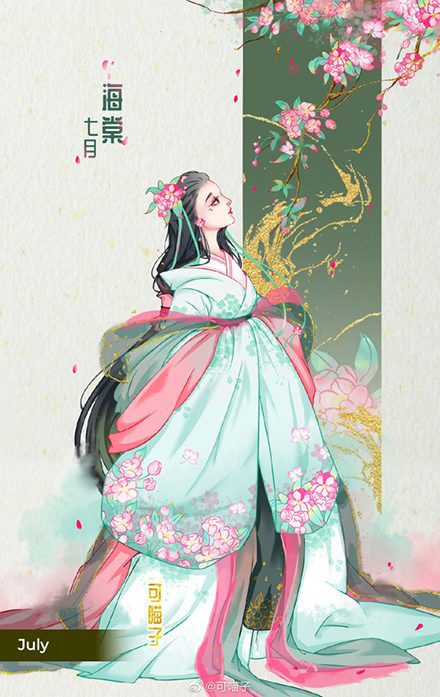
July Flower Balsamine
Flower of Beauty and Energy
Balsamine, the Flower of July, is believed as the incarnation of Phoenix, one of the most beautiful and powerful mythical animals in Chinese Mythology.
It has been widely used in medicine and cosmetology, especially for painting fingernails.
The Balsamine flower is representative of attractiveness, beauty, and energy.

August Flower Osmanthus Blossom
Flower of Moon, Noble, Honor, and Champion
Osmanthus, the Flower of August, is the representative of the moon and championship.
In Chinese mythology, there is a huge Osmanthus tree on the moon, where lives the Fairy Chang E and her bunny Yutu.
In history, the Imperial Examination, which was held to elect officials, was always held in August when Osmanthus blossoms. People who won first place in the examination were referred to as “Snapped an Osmanthus’ Twig“.
In the Chinese language, the pronunciation of Osmanthus is the same as “Richness“.
Therefore, the sweet-scented Osmanthus is the symbol of success, honor, blessing, and wealth.
Meanwhile, the Mid Autumn Festival, one of the most important Chinese holidays to celebrate harvest and reunion with family, is on the 15th of August.
On this holiday, worshiping the moon, drinking Osmanthus wine, and eating mooncakes and Osmanthus cakes are popular activities.
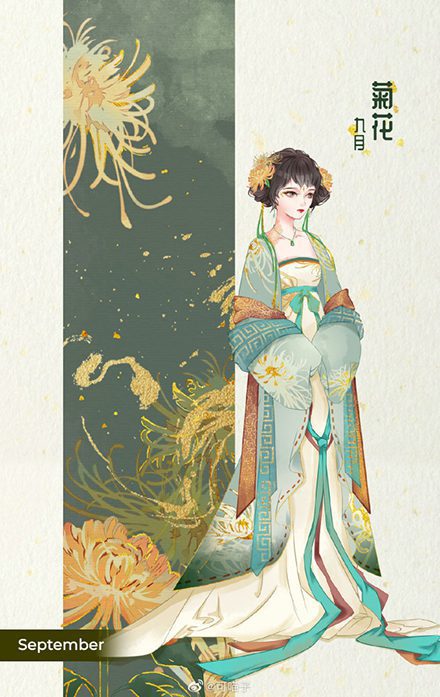
September Flower Chrysanthemum
Flower of Longevity, Auspiciousness, and Decency
Chrysanthemum, the Flower of September, blooms around the Double Ninth Festival (9th of September in Traditional Chinese Calendar), a holiday to climb mountains and respect the elders.
Additionally, nine is the strongest number in ancient Chinese culture that represents eternity.
Chrysanthemum is representative of longevity.
For over 3000 years chrysanthemum flowers have been cultivated to make food and wine, which are believed good for health, especially eyesight.
Later, Tao Yuanming (about 365 — 427), a renowned scholar frequently eulogized Chrysanthemum in his poems as a sign of integrity and fortitude.
Since then, these virtues have been highly appreciated and praised by more poets, and became one of the “Four Gentlemen” or “Four Noble Ones” in Chinese art, together with plum blossom (January Flower), orchid, and bamboo.

October Flower Hibiscus
Flower of Virtue and Beauty
Hibiscus, the Flower of October, has bright colors, beautiful appearances, and a pronunciation that is similar to the “Husband” in Chinese.
It is representative of people with outstanding morals and one’s deep longings for their loved ones.
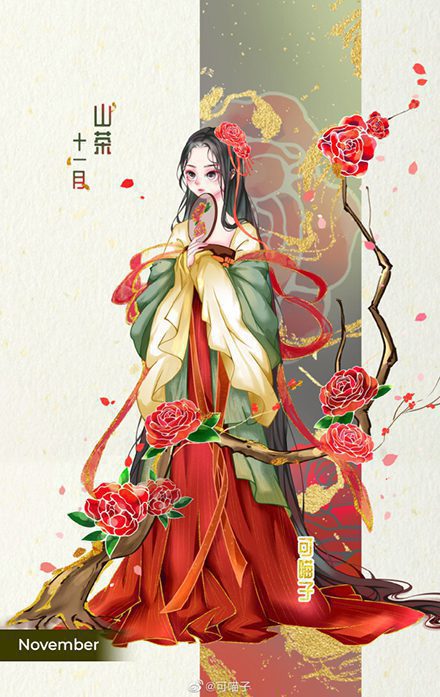
November Flower Camellia
Flower of Auspiciousness, Persistence, and Elegance
Camellia, the Flower of November, blooms in late autumn and can last for months. Since the Three Kingdoms (220 — 280), people have been planting Camellia in yards to admire the beauty, drink them as scented tea, and use them in food and herbal medicine.
The stunning beauty, rich colors, and long florescence in cold weather made Camellia the representative of auspiciousness, persistence, and elegance.

December Flower Narcissus
Flower of Purity and Blessing
Narcissus, the Flower of December, was introduced to China about 1000 years ago and was cultivated and served as herbal medicine, cosmetics, and decorative potted landscapes.
Narcissus was named as a flower fairy in the water, which has many versions in legends in regard to its incarnation.
Gorgeous flowers from the clean water and the fairy-related stories, together, made Narcissus the representative of purity and auspiciousness in Chinese culture.
We gratefully recognize that our acupuncture practice is built on the history of Chinese culture. The recording and sharing of the world’s oldest medical system which brought with it the rich cultural history of China is a gift to the western society. Asian Americans and Pacific Islanders continue to face discrimination and hate crimes at high rates.
If you have benefited and enjoyed our calendar or blog please consider a donation to: ASIAN AMERICANS ADVANCING JUSTICE, AAJC, fighting for civil rights and empowering Asian Americans to create a more just America for all.
We are grateful for information about the cultural history of Flower Goddesses from:

